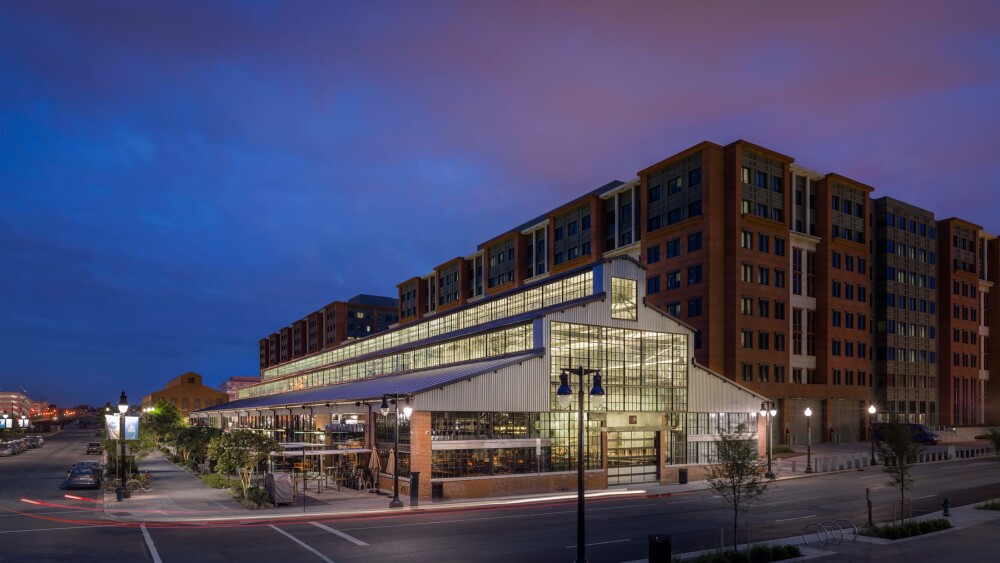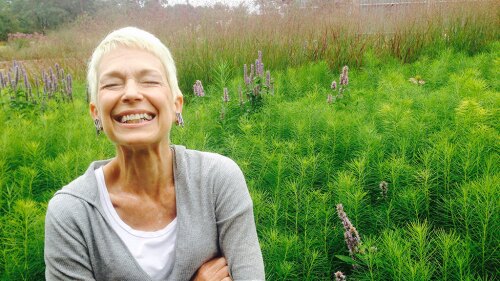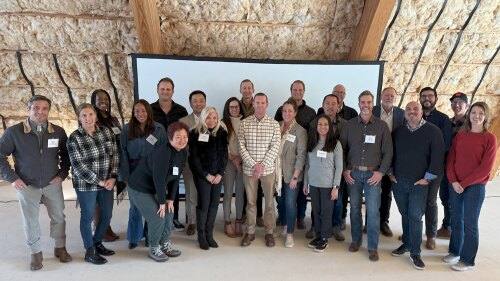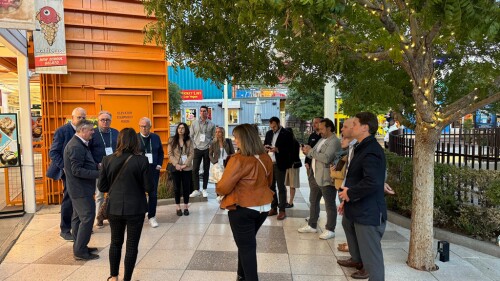![Credit Zack Benson Courtesy of Gensler_Fifth + Broadway 1[1].jpg](https://cdn-ul.uli.org/dims4/default/949a615/2147483647/strip/true/crop/1205x678+0+261/resize/1000x563!/quality/90/?url=https%3A%2F%2Fk2-prod-uli.s3.us-east-1.amazonaws.com%2Fbrightspot%2Fef%2F2a%2F67a6e80c48ed84e3da6e2e06b218%2Fcredit-zack-benson-courtesy-of-gensler-fifth-broadway-11.jpg)
Fifth + Broadway replaced the old downtown Nashville Convention Center with a pedestrian-oriented mixed-use development that incorporates residential and office towers, shops, and restaurants, along with a rooftop events space, a market hall, a live music venue, and the National Museum of African American Music.
ZACK BENSON
Experts speak about placemaking’s potential to help revitalize downtowns and to increase inclusivity and equity, ways the public sector can encourage placemaking efforts, placemaking success stories, and other related trends.
Contributing their insights: Candace Damon, Co-chair, HR&A Advisors, New York City; chair emeritus, ULI Placemaking Council; Matthew Heller, Principal, national mixed-use business development leader, DLR Group, Los Angeles; vice chair, ULI Placemaking Council, Chris Law, Founding director, the Oval Partnership, Hong Kong; co-chair, ULI Asia Pacific Placemaking Council; Vaki Mawema, Principal and comanaging director of Gensler Baltimore; chair, ULI Placemaking Council; and Kristopher Takács, Global head of stations and transit-oriented development, AECOM, Washington, D.C.; assistant chair, ULI Placemaking Council.
How can placemaking help revitalize urban cores in the wake of the COVID-19 pandemic?
Candace Damon: The fundamental question is, what do we have to get people to come back downtown? It’s obvious what the disadvantages of working at home are: we miss conversations with colleagues, we miss the energy of cities, we need a break from the kids and the dog and the husband. But the commute is a big deal in most communities. Placemaking helps establish that downtown is better than the dining room table—it’s a place where you can hang out with your friends, a place with theaters and parks, a place where you can have breakfast at the beginning of the day, go out for coffee in the middle of the day, and have a drink at the end of the day.
Matthew Heller: One of the biggest issues for struggling downtowns is the lack of office workers due to WFH [work from home]. If we can create destination quality environments, that will create a fear of missing out—people will hear about the activities taking place around food, music, arts, entertainment, and culture and want to return to downtown. To pull that off will require some visionary folks from the public and private [sectors] to come together at the table.
Vaki Mawema: [Underuse] of office buildings, driven by the impacts of the pandemic, has created opportunities for building conversions—office-to-residential being the most common—and associated placemaking in central business districts that were previously office-centric. Downtowns that previously closed after working hours are now being reimagined as 18- to 24-hour environments that leverage their centrality, character, and connectivity to create community.
Chris Law: The COVID-19 pandemic has had a major impact on mental health, especially for older people and those who were already a little isolated. Placemaking is a practice that can connect people, whether through a street festival or other event, or even through an organization that invites people to work together to prepare for a festival or event. I hope that these events make people understand the importance of public open spaces, so that when the next pandemic comes, we will be more ready to deal with it.
Kristopher Takács: Real estate pressures that traditionally drove downtown investment and redevelopment seem to be very different today than they were three years ago. And in every American city, there’s an enthusiasm to rethink our downtowns in new ways that attract vibrancy, resiliency, and life. That’s essentially what placemaking is: the intentional creation of places that excel through the right combination of programs, people, activities, culture, and economic structure. Reinvented downtowns will become greater than the sum of their parts—much greater places than the single-use neighborhoods many were crafted to be.
![Choi Wan 1[1].jpg](https://cdn-ul.uli.org/dims4/default/72dfda7/2147483647/strip/true/crop/6200x3491+0+320/resize/1000x563!/quality/90/?url=https%3A%2F%2Fk2-prod-uli.s3.us-east-1.amazonaws.com%2Fbrightspot%2Faa%2Ff4%2Fb916da9a4eccb335b4b38388561f%2Fchoi-wan-11.jpg)
As part of the ULI Art in Place Program, ULI partnered with Bank of America and Hong Kong’s Link Real Estate Investment Trust to host the Choi Wan Community “Paint and Plant” Day in April 2024, fostering community engagement and transforming the rooftop of the Choi Wan Commercial Complex in Hong Kong with new sitting and planter areas. Volunteers collaborated with local artists on a mural painting at the podium level, as well.
ULI Hong Kong
How can the public sector better encourage placemaking efforts?
Heller: Why shouldn’t every major downtown gateway city have a creative placemaking officer? In places [such as] San Francisco, Los Angeles, New York City, Chicago, that role could bring substantial value. There should also be a streamlined process that allows artists, creatives, food purveyors, and others to launch concepts and ideas much more easily. One example is the convergence of public open space with commercial enterprises, like in New York City’s Bryant Park. It’s a thriving place because it’s a public park that has commercial programming woven into it. It feels like an amazing European plaza, lined with restaurants, and people playing ping-pong, and art carts. Too often, parks are segregated from commercial retail lifestyle centers.
Law: The government can offer vacant land, public spaces, and buildings so that placemaking can happen. A lot of my work in the last three or four years has been on helping to create mechanisms so the government can supply those lands and resources to nonprofit organizations more easily and seamlessly. Often, government regulations are not designed to provide the flexibility that placemaking efforts require—you have to go through 15 different government departments to use a space. Government can also provide financial support or resources such as offering ambulances or police support for major events.
Mawema: Investment in public infrastructure [such as] streets, sidewalks, parks, and waterfronts, as well as more public/private partnerships and tax-based incentives like Washington D.C.’s Housing in Downtown program, can help support private sector placemaking activity. Adaptive reuse and renovation projects always present opportunities to simultaneously build back critical infrastructure and improve the public realm to move the city forward.
Takács: Business improvement districts, community groups, housing associations, and other civic coalitions [that] have traditionally acted independently of one another are coming together more. They are pulling resources, inviting ideas, finding artists, and encouraging competitions to make places not only more attractive but also more fun and more inclusive and equitable. Placemaking is a vehicle to extend the joy of the city. This isn’t always a question of spending money or rebranding a place: it’s about unleashing creativity to discover the uniqueness that makes people love being together, with authenticity and staying power. Placemaking leads to pride of place.
Damon: In many jurisdictions, commercial property is taxed at a higher rate than residential property, for obvious reasons. But if residential properties are now being used much more often as home offices … city government coffers are reduced because more people work from their homes, and commercial office leases are down, we may have to rethink how we tax properties. This could help bring people back downtown. Otherwise, employees are subsidizing their employers.

Through a mix of adaptive use and new construction, The Yards redevelops formerly industrial lands along the Anacostia River in Washington, D.C. into a walkable mixed-use environment with office space, residential buildings, shops, and a large waterfront park that hosts concerts, fitness classes, and other events year-round.
Prakash Patel/Prakash Patel
Can placemaking foster diversity, equity, and inclusion in communities?
Takács: Yes, [and] it starts with opening a conversation. Fostering diversity, equity, and inclusion is a multilayered process of welcoming and belonging. People love to talk about their neighborhood—past, present, and future. We don’t often have the occasion to do that together, openly and freely. The placemaker can convene and sustain [such a] conversation. Being mindful of “who” we are as a community is as important—if not more vital—than “what,” “where,” and “how” we make a place around us.
Law: People often interact only with the kind of people they’re used to. A good placemaker needs to make sure that volunteers [who] help raise funds or sponsor projects don’t turn public spaces into a club. Everyone needs to understand, from day one, that what we are doing together is about the public good. In addition, placemakers have to ask themselves, do I have any prejudices or cognitive biases? You have to understand your own biases to make sure you don’t fall into a trap, as well.
Damon: The concept of placemaking, as many progressives have pointed out, is a little odd, because it suggests that there was no place before the placemaking effort. That’s obviously not the case in a modern city. Part of the answer to increasing equity and inclusion is to consider what the place is that we are unmaking to make the new place, and whether the people who used the original place are being welcomed in the new place. Urban cores need to be the place where the diversity of the region gathers and feels welcome.
Heller: Yes, through intentionality and purposeful placemaking. One real-world example is Freedom West Homes on four city blocks in San Francisco. It’s an urban renewal approach based on equity by design. Freedom West is an existing, low-scale, nearly 400-unit minority-owned cooperative that is not economically sustainable. We created an equity-by-design framework to develop non-negotiable guiding principles for the residents and worked with MacFarlane Partners to redevelop their land and build them equity at no cost to them. Octavia Street will become a pedestrian public realm, and a new plaza will be created for the co-op’s communal gathering space.
Mawema: Placemaking plays a major role in the design of inclusive places, providing a variety of ways to engage with a site. A good case study is Baltimore’s Harborplace, which is currently an insular destination that cuts off downtown Baltimore from the water of the Inner Harbor, the city’s most treasured placemaking asset. The new plan by MCB Real Estate and Gensler reconnects the city to its waterfront and democratizes the ground plane with enhanced universal pedestrian and vehicular access, intentional viewsheds, and a reimagined public park and waterfront promenade, granting all Baltimoreans the opportunity to gather and celebrate their great city.
What recent placemaking success stories should more people know about, and why?
Law: Recently, ULI Hong Kong partnered with the Bank of America and Link Real Estate Investment Trust to host a community event to transform the rooftop of Hong Kong’s Choi Wan Commercial Complex into a garden with planters and sitting areas and shade structures. It was also an opportunity for local kids to come together with artists, volunteers, and residents of the Choi Wan Estate public housing.
Mawema: The most interesting placemaking success stories are about developments that seamlessly become the connective fabric that stiches communities together. Fifth + Broadway in Nashville is a great example of placemaking that balances the needs of locals and tourists. The Yards in Washington, D.C., is an example of how design can successfully create a sustainable, thriving neighborhood from scratch, while becoming a catalyst for waterfront reclamation.
Damon: As the gateway cities struggle with housing affordability, there is a renaissance in smaller cities, many of which have learned from what the larger cities have already attempted with respect to diversity of funding; sustainability of operations; and incorporation of diversity, equity, and inclusion. I’ve been involved with the new Bay Park in Sarasota, Florida, a rapidly growing city. It is going to be a spectacular park and cultural complex, and the first phase is now open, with its performing arts anchor still to come. It [features programming] virtually every day.
Heller: Little Island, a relatively new public park in New York City’s Hudson River Park, is a dynamic space with an amphitheater, space to wander, food and beverage offerings, and play areas. The Anaheim Packing District developed by LAB Holding, is another good example of how place can be catalytic. The Bishop Arts District in Dallas [revolves] around local art purveyors, retail, and food and beverage.
Other placemaking trends you’re excited about?
Mawema: I feel encouraged by the public and private partnerships that are forming to focus resources on ways that truly revitalize downtowns across the country. It’s more important than ever before that our local, state, and federal governments be a unified front in saving our cities’ assets from their ongoing challenges and [create] lasting change.
Takács: I’m excited about the trend to convert distressed office buildings in our downtowns into multifamily housing. We are seeing an incredible momentum and leadership on the government side, with strong desire and creativity on the private-sector side, to transform these empty or failing buildings into real community assets. Residential conversions can contribute much more vitality to downtown life than a Class B or C office building could ever dream of. Let’s do this in a creative way that brings multigenerational residents, small shops, and services to support a walkable lifestyle without the car. Of course, it’s very expensive and sometimes impractical to convert old office buildings to housing, but the potential upside for placemaking downtown is well worth the stretch.
Damon: It’s not that new a trend, but I’m excited about greenways and urban trails. They are inclusive almost by definition, because they connect one place to another, and they bring people through places they might not travel otherwise. They’re relatively cheap to build and operate, as well, compared to a big new signature park.





